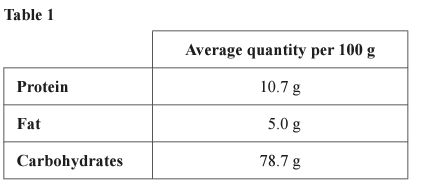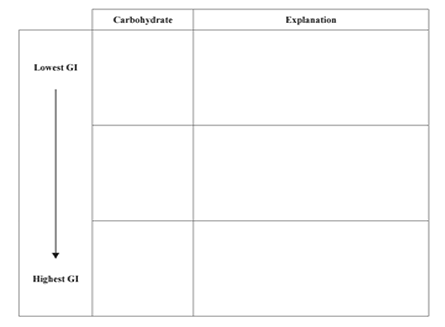1. In a protein, hydrogen bonding takes place during the formation of the
A. secondary, tertiary and quaternary structures only.
B. primary, secondary and tertiary structures only.
C. tertiary and quaternary structures only.
D. primary and tertiary structures only.
Solution

2. Consider the following four fatty acids: arachidonic, linoleic, linolenic and stearic. Which one of the following statements related to these four fatty acids is correct?
A. Both linoleic acid and stearic acid are omega-3 fatty acids.
B. Linolenic acid is an omega-3 fatty acid and contains three C=C double bonds.
C. Arachidonic acid is an omega-6 fatty acid and contains three C=C double bonds.
D. Both linoleic acid and arachidonic acid are omega-6 fatty acids and contain one C=C double bond.
Solution

3. The molar mass of glycerol, C3H8O3 , is 92.0 g mol-1. The production of 65.0 g of C3H8O3 from tripalmitin, C51H98O6 , which is a triglyceride
A. requires 12.7 g of water.
B. requires 38.2 g of water.
C. produces 12.7 g of water.
D. produces 38.2 g of water.
Solution

4. Enzymes are commonly not effective in acidic conditions because acids
A. change the charges on the enzymes.
B. react with the enzymes to form zwitterions.
C. esterify the enzymes into smaller molecules.
D. react with the carboxyl groups on the enzymes’ amino acid residues.
Solution

5. The molar heat of combustion of glucose, C6H12O6 , in the cellular respiration equation is 2805 kJ mol-1 at standard laboratory conditions (SLC). Which one of the following statements about cellular respiration is correct?
A. Cellular respiration is an endothermic reaction.
B. The products of cellular respiration are carbon and carbon dioxide.
C. Cellular respiration is a redox reaction because C6H12O6 accepts electrons from oxygen.
D. When one mole of oxygen is consumed in the reaction, 467.5 kJ of energy is released.
Solution
6. Which one of the following statements about sweeteners is correct?
A. Glucose and fructose are optical isomers.
B. Glucose reacts as a monomer in the body.
C. 2 mol of glucose has the same energy content as 1 mol of sucrose.
D. Sucrose has an energy output almost 200 times the energy output of aspartame.
Solution

7. Consider the following statements about enzymes and coenzymes:
I Enzymes and coenzymes are not changed during the catalytic reaction.
II All catalytic reactions require a coenzyme to proceed.
III Coenzymes can lose or gain electrons during a catalytic reaction.
IV Coenzymes are inorganic molecules derived from vitamins.
V Coenzymes can change the binding properties of an enzyme to allow a reaction to occur.
Which of the statements above are correct?
A. I, IV and V only
B. II and IV only
C. I, II and III only
D. III and V only
Solution

8. Collagen is found in muscles, joints and skin. It is the most abundant protein in the body. Gelatin can be made by boiling animal collagen in water for many hours. Collagen and gelatin are made from the same 18 amino acids. Gelatin is more easily metabolised by the body than collagen.
i. Gelatin is produced when collagen is broken into smaller molecules. Name the chemical reaction that produces gelatin from collagen. 1 mark
Solution
ii. Explain how consuming gelatin can be useful in increasing collagen levels in the body. In your answer, identify any chemical processes involved.3 marks
Solution

9. Vitamin C is required for the production of collagen in the body.
i. What is the source of the vitamin C present in the body? Justify your answer. 2 marks
Solution
ii. Vitamin C is added to some foods to help prevent spoilage. State how vitamin C can slow the rate of oxidative rancidity in some foods. 1 mark
Solution

10. Corn makes up a large proportion of people’s diet in some parts of the world. Air-popped popcorn is made from whole corn kernels. The nutrition content of a particular type of air-popped popcorn is provided in Table 1

a. Using the information provided in Table 1, calculate the energy content of air-popped popcorn in kilojoules per gram.
Solution

b. Carbohydrates are the main source of energy in corn. Chemical analysis shows that the carbohydrates in corn include amylose, amylopectin and cellulose. Complete the table below by ranking these three carbohydrates from lowest to highest on the basis of their glycaemic index (GI).

Explain your ranking for each.
Solutions

c. When corn is picked it tastes sweet. Farmers recommend eating corn soon after picking. Once picked, the sweetness of the corn begins to decrease as glucose reacts to form starch. One way to help keep the sweetness for longer is to boil the corn for about two minutes and then freeze it. Identify how boiling and then freezing corn helps to keep it sweet for longer. 2 marks
Solution

11. Corn oil is produced from corn and it is commonly used to deep-fry food. Table 2 shows the percentage fatty acid composition of a corn oil sample

Explain, with reference to its fatty acid composition, why corn oil is a liquid at SLC. 3 marks
Solution
